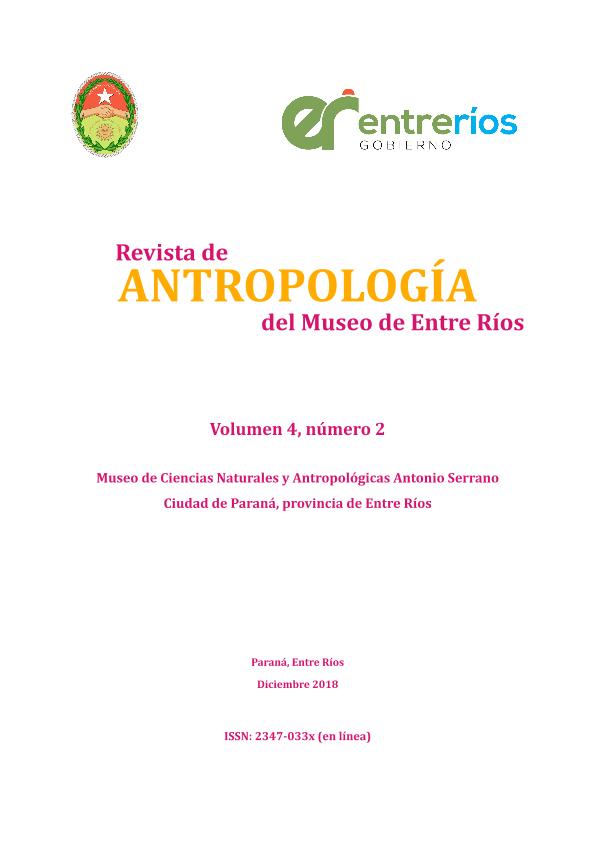Mostrar el registro sencillo del ítem
dc.contributor.author
Escosteguy, Paula Daniela

dc.contributor.author
Gonzalez, Maria Isabel

dc.contributor.author
Frere, Maria Magdalena

dc.contributor.author
Sokol, Olivia Lucía

dc.contributor.author
Rivas Gonzalez, Miranda

dc.contributor.author
Fernandez, Alejandro Ezequiel

dc.contributor.author
Grzegorczyk, Micaela

dc.date.available
2022-11-02T18:32:08Z
dc.date.issued
2018-12
dc.identifier.citation
Escosteguy, Paula Daniela; Gonzalez, Maria Isabel; Frere, Maria Magdalena; Sokol, Olivia Lucía; Rivas Gonzalez, Miranda; et al.; Ocupaciones prehispánicas en las lagunas Esquivel y del Medio (Depresión del río Salado bonaerense); Museo de Ciencias Naturales y Antropológicas "Prof. Antonio Serrano"; Revista de Antropología del Museo de Entre Ríos; 4; 2; 12-2018; 16-28
dc.identifier.issn
2347-033X
dc.identifier.uri
http://hdl.handle.net/11336/176063
dc.description.abstract
Los estudios arqueológicos en la microrregión del río Salado bonaerense comenzaron a fines del siglo XIX. En particular, nuestro equipo de investigación inició tareas sistemáticas de prospección y excavación desde 1984 que permitieron conocer las ocupaciones de grupos cazadores-recolectores-pescadores durante el Holoceno tardío. En este artículo presentamos los primeros resultados obtenidos a partir de los trabajos de campo realizados en la estancia Tajamar, donde se ubican las lagunas Esquivel y del Medio que desaguan en el ríoSalado. A partir de las prospecciones y sondeos realizados se han recuperado fragmentos de alfarería, artefactos líticos y restos faunísticos. En una visión de conjunto, la articulación de estos estudios permite profundizar la omprensión de las ocupaciones humanas en el entorno de lagunas, ambiente que resultó atractivo por su oferta de recursos vegetales y animales, aunque pudo haber sido ocupado con diferente frecuencia que los sitios cercanos al curso del río Salado.
dc.description.abstract
Archaeological studies in the Salado River microregion of Buenos Aires province began at the end of the 19th century. In particular, our research team initiated systematic exploration and excavation tasks since 1984 that allowed us to know the hunter-gatherer-fisher groups’ occupations during the late Holocene. In this article we present the first results obtained from the field works carried out in the Tajamar ranch, where the Esquivel and Del Medio lakes are located. These water bodies drain into the Salado River and are connected through Tajamar stream. Pottery sherds, lithic artifacts and faunal remains have been recovered from the prospections and reconnaissance. Pottery was quantified and analyzed macroscopically, according to its techno-morphological features. Out of 222 sherds, 51 could not be determined and were not taken into account. Body fragments (N = 150) are predominant, while rim fragments are less frequent (N = 21). A morphological type of bowl recognized for the region was obtained from the macroscopic analysis and 3D projection. This allows us to evaluate the possible uses and ceramic variability available in the area, to get closer to a complete view of the containers and to generate an updated virtual inventory of the different morphologies. As for the lithics, raw materials were identified. The predominant were phtanite, orthoquartzite from the Sierras Bayas Group, metaquartzite and other minor ones such as dolomite, silicified limestone and rhyolite. All 127 artifacts recovered were classified, according to typological classes, into nuclei, debitage and formatted artifacts. The faunal analysis consisted in the quantification and anatomical and taxonomic identification of the six fragments recovered and their subsequent taphonomic analysis in search of anthropic evidence and naturally originated marks. Cervidae (N = 1), large mammalia (N = 2) and medium-large mammalia (N = 2) were identified. The remaining specimen could not be determined. In an overview, the articulation of these studies allows us to deepen the understanding of human occupations in the lake environment. This was attractive for its supply of plant and animal resources, although it may have been occupied with different frequency than sites near the course of the Salado River.
dc.format
application/pdf
dc.language.iso
spa
dc.publisher
Museo de Ciencias Naturales y Antropológicas "Prof. Antonio Serrano"
dc.rights
info:eu-repo/semantics/openAccess
dc.rights.uri
https://creativecommons.org/licenses/by-nc/2.5/ar/
dc.subject
HUMEDAL DEL RÍO SALADO
dc.subject
HOLOCENO TARDÍO
dc.subject
CAZADORES-RECOLECTORES-PESCADORES
dc.subject
PAMPA ARGENTINA
dc.subject.classification
Arqueología

dc.subject.classification
Historia y Arqueología

dc.subject.classification
HUMANIDADES

dc.title
Ocupaciones prehispánicas en las lagunas Esquivel y del Medio (Depresión del río Salado bonaerense)
dc.type
info:eu-repo/semantics/article
dc.type
info:ar-repo/semantics/artículo
dc.type
info:eu-repo/semantics/publishedVersion
dc.date.updated
2022-11-01T18:09:37Z
dc.journal.volume
4
dc.journal.number
2
dc.journal.pagination
16-28
dc.journal.pais
Argentina

dc.journal.ciudad
Entre Ríos
dc.description.fil
Fil: Escosteguy, Paula Daniela. Consejo Nacional de Investigaciones Científicas y Técnicas; Argentina. Universidad de Buenos Aires. Facultad de Filosofía y Letras. Instituto de Arqueología; Argentina
dc.description.fil
Fil: Gonzalez, Maria Isabel. Universidad de Buenos Aires. Facultad de Filosofía y Letras. Instituto de Arqueología; Argentina
dc.description.fil
Fil: Frere, Maria Magdalena. Universidad de Buenos Aires. Facultad de Filosofía y Letras. Instituto de Arqueología; Argentina
dc.description.fil
Fil: Sokol, Olivia Lucía. Consejo Nacional de Investigaciones Científicas y Técnicas; Argentina. Universidad de Buenos Aires. Facultad de Filosofía y Letras. Instituto de Arqueología; Argentina
dc.description.fil
Fil: Rivas Gonzalez, Miranda. Universidad de Buenos Aires. Facultad de Filosofía y Letras. Instituto de Arqueología; Argentina
dc.description.fil
Fil: Fernandez, Alejandro Ezequiel. Consejo Nacional de Investigaciones Científicas y Técnicas; Argentina. Universidad de Buenos Aires. Facultad de Filosofía y Letras. Instituto de Arqueología; Argentina
dc.description.fil
Fil: Grzegorczyk, Micaela. Universidad de Buenos Aires. Facultad de Filosofía y Letras. Instituto de Arqueología; Argentina
dc.journal.title
Revista de Antropología del Museo de Entre Ríos
dc.relation.alternativeid
info:eu-repo/semantics/altIdentifier/url/https://ramer.ar/revista/index.php/ramer/article/view/34
Archivos asociados
